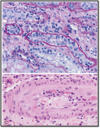RENAL PATHOLOGY 2 Flashcards
Covers Vascular Kidney Disorders & Tubulointerstitial disorders, (82 cards)
Etiology of chronic pyelonephritis
oInadequately treated acute pyelonephritis
orecurrent and persistent bacterial infection due to urinary tract obstruction, urine reflux, or both
What electrolyte imbalance must be watched for in the recovery phase of acute tubular injury?
Hypokalemia
Pre renal causes of acute kidney injury due to volume sequestration
pancreatitis, peritonitis, rhabdomyolysis
Underlying mechanism for Thrombotic Thrombocytopenic Purpura
Deficiency of ADAMTS13–> Very large vWF multimers –> bind platelet surface glycoproteins and activate platelets spontaneously –> microthrombi

Gross morphology of reflux associated chronic pyelonephritis
Scars in the upper and lower poles
Irregular, discrete overlying deformed and blunt calyces

Why is there eventual supression of renin synthesis in bilateral RAS/ RAS in a solitary functioning kidney?
Lack of pressure natriuresis
(see image for detailed explanantion)

3 causes of Classical Distal Renal Tubule Acidosis (Type 1)
- Sjogren Syndrome
- Rheumatoid arthritis
- Drugs- Lithium
Morphology of chronic transplant rejection
- intimal thickening , vascular occlusion
- interstitial fibrosis, tubular atrophy

Morphology of acute cellular rejection
- extensive interstitial inflammation and tubular inflammation
- Inflammation of vessels with/without necrosis

definition of oliguria
urine output of less than 400 mL/day or less than 20 mL/hr.
In a patient with bilateral functioning kidneys and unilateral RAS, what happens to the renin levels in the non stenotic contralateral kidney?
decreased renin secretion
How does typical HUS lead to microthrombi formation?
Shiga like toxin(Stx) binds to the globotriasylceramide Gb3 receptor on the renal endothelium –> damage to the endothelium–>platelet activation and vasoconstriction, reduced NO –> microthrombi.
Important renal manifestation of invasive cervical cancer?
bilateral hydronephrosis and renal failure
Diagnosis?
fever+ eosinophilia+ rash + hematuria, rising serum creatinine
Acute Drug-Induced Interstitial Nephritis
Morphologic feature of analgesic nephropathy
Papillary necrosis assoc with dystrophic calcification

Identify this important cause of renal artery stenosis from the clues below:
young to middle aged female hypertensive patients
mid and distal portion of the artery
“string of beads” on angiography
Fibromuscular disease
Mechanism of analgesic nephropathy
Phenacetin and its metabolites concentrate in the medullary interstitium–> induce generation of reactive metabolites–> direct covalent binding and oxidative damage –>cell injury
Kidney morphology in multiple myeloma
Dilated tubules with eosinophilic casts with Tamm-Horsfall protein trapping light chains

Post renal causes of acute kidney injury
- obstruction at the urethra or bladder outlet
- bilateral ureteral obstruction
- unilateral obstruction in a patient with a single functioning kidney.
Gross appearance of the kidney in malignant nephrosclerosis
fibrinoid necrosis + intraluminal thrombosis and rupture of glomerular capillaries and arterioles –> petechial hemorrhage on the cortical surface –>flea bitten kidney appearance

Morphology of antibody mediated acute rejection
inflammation of glomeruli and peritubular capillaries

Two microscopic features of chronic pyelonephritis
Thyroidization of tubules – atrophied/dilated tubules with colloid like casts
Chronic interstitial inflammation and fibrosis

Pre renal causes of acute kidney injury due to decreased circulating blood volume
Hemorrhage
Burns
Diarrhea
Diuretics
Gross appearance of the kidney in benign nephrosclerosis
Finely granular cortical surface (grain leather)





















